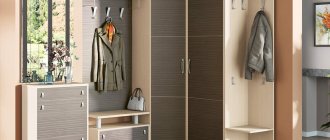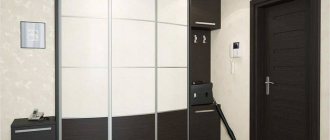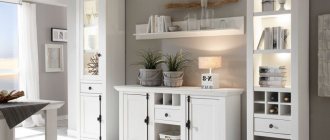Small kitchens quite often force housewives to install a refrigerator in the hallway, if its dimensions allow and the corridor area is sufficient. If the hallway also smoothly transitions into the kitchen, then the best solution to the problem has been found. You should not be afraid of this option; the main thing is to carry out the planning and calculations competently and thoughtfully. It should not only be convenient, but also beautiful.
When deciding whether to move the refrigerator into the hallway, you need to take into account some features.
Options for placing a refrigerator in the hallway
The corridor space to accommodate the unit sometimes has to be slightly altered. It’s good if the hallway has a niche or a built-in cabinet. Then putting a refrigerator there is quite acceptable. It is recommended to connect the product directly - without using extension cords. Therefore, an outlet is installed in the immediate vicinity of the device.
The refrigerator will not look alien if you organize a storage system around it or install a coffee bar
There are also places where installing such equipment is prohibited:
- near heating radiators (extremely rare, but they are found in the corridor);
- near heaters, as well as on heated floors;
- in direct sunlight (if there is a window in the hallway);
- if the item is located at the entrance to the kitchen area, its open door should not block the interior doorway;
- Feng Shui philosophy prohibits placing a refrigerator near the wall, which is the border between the bathroom and the hallway.
Sometimes you don’t have to hide the refrigerator, but turn it into an art object by choosing the design to match the interior of the hallway
Built-in cabinet
A tall or compact refrigerator in a closet in the hallway allows you to preserve the style of this room as much as possible. The structure here is hidden behind one of the sliding, hinged doors. The hallway itself looks as if there are only cabinets in it - you can suspect the presence of equipment only by the sound (not always).
It’s hard to guess that behind the doors of an ordinary-looking wardrobe there could be a bulky refrigerator hidden.
A small horizontal structure is also carefully built into a cabinet or cabinet, masking it with a countertop or facade.
Option for placing a refrigerator inside a wardrobe
In a niche
It is very convenient to place the refrigerator in a niche in the hallway. It is hidden behind a screen, curtain, sliding doors, or simply placed in the available space without blocking anything. Painting or covering an object with colored film is quite acceptable.
Refrigerator in a niche specially equipped to accommodate a household appliance
Around the corner
Hiding the refrigeration structure around the corner is also a very convenient option. The unit is installed behind a small homemade partition, any bend in the room. Placing it next to other tall furniture will also fit in with the theme.
A corner in the hallway near the kitchen is a great place if the refrigerator fits perfectly into the corner in size
Near the wall
A beautiful, new refrigerator does not have to be hidden. It is permissible to simply place it near the wall, along with other furniture items. A distance of at least five cm must be left from the back wall to the main surface.
It is important that the handle of the refrigerator does not interfere with the free movement of people and does not disturb anyone
A black refrigerator will fit perfectly into a loft or Scandinavian interior
Microwave oven (microwave oven)
Built-in microwaves are, of course, more expensive than freestanding ones, but they perfectly highlight the design of the kitchen. Such stoves initially require air exhaust; remember this when you want to install a free-standing one.
| Rice. 21. Non-built-in microwave oven in the pencil case section behind the door, which is lifted with the help of Aventos |
| Rice. 22. Built-in microwave oven in the lower part of the kitchen |
| Rice. 23. Built-in microwave oven in the upper part of the kitchen |
You have decided where to place the microwave oven in the kitchen, keep useful tipsPlaces for placing a microwave oven in the kitchen: on the countertop and apron, also in the pencil case, upper cabinet and lower cabinet. Let's look at the advantages and disadvantages. |
There are microwaves with the functions of oven, grill, convection (fan) and steamer.
This is a whole orchestra: the oven and grill will prepare a juicy dish with a crust or bake it, and convection is responsible for uniform heating.
For a steamer, you need to fill the generator with water. The downside to using a double boiler is that it gets very dirty, although there are models with a pyrolysis function (when fat is burned at a high temperature).
| Rice. 24. Built-in compact oven with microwave functions |
What dishes are not recommended for use in the microwave:
any metal, otherwise there may be a short circuit or even an explosion with ornaments like gold and silver with cracks, crystal, be careful with plastic, because not everything can be heated.
Read further:
|
If you have a small kitchen or the long-awaited 5 places
Somewhere, but in the kitchen in the Khrushchev-era building you definitely won’t be able to make circles! And the layout of apartments in new buildings tends to reduce kitchen space.
What can you do for a small kitchen? Here's what:
- 1. If there's absolutely not enough space for a refrigerator, consider whether you can place it in a hallway, closet or room, perhaps mounted in a cabinet, giving it a more room-appropriate look. Pros: an obvious advantage is the solution to the issue of placing the unit, and in some cases this, unfortunately, is the only option that allows you to gain at least some free space for movement.
Cons: if you are not afraid of making circles along the route corridor-kitchen or room-kitchen, then we must remind you that the refrigerator is a rather noisy device. Modern models generally tend to make very strange sounds, but what can we say about older models. Are you ready for these sounds to come to you from the corridor or become part of your room?Another drawback. What do you associate a refrigerator with? That's right, with food, like everyone else. Will it not be an unnecessary reminder about food and a reason, for example, to eat unscheduled between lunch and dinner or to “sin” again and eat too much at night?
- 2. A more radical option may seem to be connecting the kitchen to a balcony or loggia.
This also includes combining a kitchen with a room to create a studio room that is quite popular in modern interiors. Pros: solution to the placement issue; it is possible to reduce the distance between the refrigerator and the kitchen table compared to the previous option. Cons: in the case of a loggia, it would be nice if the refrigerator did not heat up in the sun all day - to avoid this, you can use curtains or blinds on the windows. Keep in mind that all kitchen smells and sounds will be present in your room. In the photo you can see examples of interiors where these recommendations were successfully applied. - 3. Sliding doors to the kitchen.
In some cases, this completely resolves the situation, because you fill the non-functional space. Pros: obvious. Cons: dismantling the door, which is not always possible. - 4. The simplest, but far from budget option, is a non-standard refrigerator size or a wall-mounted version.
A narrow refrigerator can easily fit into a small cabinet; it can also be placed in a shallow niche. The facade of a wall-mounted refrigerator may be no different from the facade of kitchen furniture. And if you do not purchase a ready-made option that suits you externally, you can always decorate it yourself, since there are many quite accessible methods and materials. But the main goal, you see, will be achieved. Pros: obvious. Cons: high prices and possibly a long search for suitable sizes. - 5. Similar solutions to the situation include separate modules for the refrigerator and freezer (for example, there is a mini-freezer 85 cm high), which can be placed under kitchen furniture and work surfaces, designing their façade to match the kitchen furniture.
Pros: obvious. Cons: as in the previous option: it will be expensive and time-consuming to find the perfect size.
We are glad that this article turned out to be informative for you, and even more so - it helped to bring comfort and beauty to the interior of your small or large kitchen.
Small kitchens, features of some interior solutions or living in communal apartments - all these situations may require placing a refrigerator in the hallway. You should not be afraid of such a step; the main thing is to calculate the dimensions of the equipment and the available space in the corridor.
At the same time, you should not clutter the hallway or place the refrigerator in an inconvenient place, because nothing should interfere with the movement of people and the arrangement of things.
The refrigerator should not “break” the working triangle
The essence of the so-called working triangle is the visual unification of the main fragments of space. These include the stove, sink and refrigerator. The main parts are considered to be the cooking, washing and storage area. It is on them that a competent approach to ergonomics in the kitchen is based.
In different layouts, this triangle can be “folded” in different ways. In the linear layout, the third point is the dining table, which is used as an additional work surface. The kitchen island works on the same principle.
L-shaped kitchen design
In L-shaped and U-shaped kitchens, it is possible to install a working triangle in small spaces so that all elements are at hand. In a parallel layout, it is worth distributing the work triangle so that the stove and sink are located on one side, and the refrigerator next to the work surface is on the other.
In a conventional working triangle, you need to find the optimal place for the refrigerator, depending on the dimensions of the room and layout.
How and where to hide a refrigerator in the kitchen: 7 interesting ideas
Home/Interior/
21 Jun 2022 No
The refrigerator is one of the most important appliances in the kitchen. Today it is impossible to imagine a single house or apartment without this assistant. In addition to its great importance for every housewife, refrigerators are also not small in size. Very often they take up huge space in the kitchen, thereby “eating up” valuable square meters. But even this problem can be solved without much difficulty. Below are 7 options on how you can hide a refrigerator in the kitchen and beyond.
1. Installing a refrigerator outside the kitchen. The simplest and most obvious option is to move the refrigerator to another room. It can be in the hallway, one of the living rooms or even in the living room
In this case, it is important to take into account the fact that the refrigerator can irritate you and other family members with its noise during vacation, so before making a rearrangement, it is better to discuss everything several times with your loved ones
A loggia can be an excellent option for locating the refrigerator. In this case, technical conditions must be met, the main ones of which are: moderate humidity in the room, a sufficiently warm temperature in it during the cold season, and the loggia must be constantly ventilated. Otherwise, if all these requirements are not met, the refrigerator will simply fail.
Moreover, you can try to combine the loggia with the kitchen, but you should remember that in this case such changes must be formalized legally, and also coordinated with the rest of the family members and neighbors.
2. Shouldn't you try experimenting with the size? Think about it: do you really need a full-size refrigerator or can you get by with a mini version? Maybe you can completely dispense with the freezer or install it separately? In this case, you will be able to save precious space in the kitchen. This option is ideal for those people who live alone, because a mini-fridge is quite enough for one person.
3. Hide the refrigerator under the stairs. If you are the owner of a house or apartment with two floors, then the refrigerator can be hidden under the stairs, because in fact there is enough space for an entire pantry. The main thing is that you need to take care of creating a heat sink, because in a closed space the refrigerator can quickly overheat and break down.
By installing the refrigerator under the stairs, you don’t even have to resort to additional means of disguising it, because, being in such a place, it is visually lost without attracting undue attention to itself.
4. Refrigerator in the closet. Today, a huge number of kitchen furniture sets are made with a special cabinet designed for a refrigerator.
When purchasing this option, you should pay attention to the fact that the back wall of the refrigerator cabinet has a ventilation grill, which will help prevent it from overheating.
5. Camouflage. At first glance, this may seem very strange, but one of the camouflage options is to install the refrigerator in the most visible place! In this case, its surface can be used as a slate board. Today, there are many types of special paints and devices that can be used to turn an ordinary refrigerator door into a note board in order to leave reminders and recipes on it.
6. The refrigerator is a wall of memories and joyful emotions. Using ordinary vinyl film and your favorite photographs, you can make a real memory board or a gallery of your best and favorite photographs from an ordinary and unremarkable refrigerator. Now you don’t have to hide this bulky piece of household appliances anywhere!
7. Use your imagination! Any refrigerator can be turned into a real work of art. You just need to turn on your imagination, and you can bring your ideas to life using full-size magnetic panels with a variety of ornaments and patterns.
The best built-in models at affordable prices
This is a relatively inexpensive model of a built-in refrigerator from a manufacturer from Belarus. It has two chambers, with the freezer located at the bottom. The device consumes about 290 kW/h of electrical energy per year. Isobutane is used as a refrigerant. Unfortunately, due to savings, Belarusians decided to abandon the implementation of the “no frost” system, and only a drip defrosting system is used. The device makes almost no noise (although this does not apply to all copies). Otherwise, this is a typical Belarusian-made refrigerator. You have heard about many such devices more than once. The only difference between this model and the others is that it is a built-in refrigerator.
Advantages:
- There are glass shelves inside the device.
- Able to keep cold when turned off for up to 16 hours.
- Simple electromechanical control.
- Relatively small size.
- The chamber volume is 168 liters.
Choosing the best built-in refrigerator is not easy, so there are a few more options to consider.
This is a pretty good model for those who like to save on electrical energy. the fact is that such a model belongs to energy consumption class A+. The manufacturer says that such a device consumes no more than 290 kW/h per year. Unfortunately, the refrigerator has the typical disadvantages of an inexpensive device. This can be seen in the fact that from time to time you will need to spend time defrosting, and not every person will appreciate the fact that the volume of the freezer is only 61 liters. But the volume of the refrigerator itself has been increased to 223 liters, and this is enough even for a large family.
Advantages:
- Electromechanical control is used.
- Relatively low electrical energy consumption.
- Large refrigerator.
- Glass shelves can withstand any load.
- Minimum noise level.
Flaws:
- Very small freezer.
- Sometimes defrosting is required.
- Very thin plastic is used.
Let's consider another model.
Corting KSI 17850 CF
The creators of such a device decided to make everything as simple as possible. The control consists of a standard temperature regulator, and the device consists of two chambers, each of them located behind its own door. There is no “no frost” system, which means you will have to defrost the refrigerator manually from time to time. Inside the device there are glass shelves, and the total volume of space is 274 liters. The freezer compartment has a share of 70 liters, and it cannot be said that this is enough.
Advantages:
- Has an A+ electricity consumption class.
- The controls are quite simple.
- The refrigerator compartment is very large.
- There are no complaints about the reliability of glass shelves.
- The presence of a chrome shelf for storing bottles of water or drinks.
Flaws:
- The device needs to be defrosted regularly.
- The compressor is not the most reliable.
- Some specimens have a high noise level.
Next, we suggest considering the TOP models.
Technical nuances
Only a highly qualified technician should install built-in equipment!
If the device breaks due to a makeshift installation, repairs under warranty will most likely not be possible. However, even those who will call a technician to your home need to know a number of technical details.
The refrigerator cabinet must be perfectly level and stable.
And most importantly, it must provide the unit with unhindered access of air to cool the heating elements. To do this, it is done:
- Without back wall.
- With holes in the back and side walls.
- With a margin of width and height.
- With a podium for installing a ventilation grille.
It is also important to understand the types of fastening of the facade to the refrigerator door. Built-in appliances have special fastenings on the front surface
Most often there are two types of fastenings - like guides and hinged
Built-in appliances have special fastenings on the front surface. Most often there are two types of fastenings - like guides and hinged.
A mechanism with guides “hangs” the façade on the refrigerator door, and when opened they slide relative to each other. This type of fastening leaves gaps between the doors where debris can accumulate. In addition, the door can only be opened at an angle of up to 90°
. But it is ideal if the cabinet door itself is quite heavy, because... the load is distributed over several places.
The hinge firmly connects one door to another.
There are no gaps with this connection option and the door literally opens wide open. However, hinges are not suitable for a heavy facade (for example, made of solid wood).
Ideally, at the stage of designing a kitchen unit and choosing equipment, you should consult with an installation specialist. A specialist will be able to compare your design desires and the technical capabilities of the refrigerator.
Embedding Features
If you prefer a built-in refrigerator, you should, of course, pay attention to the features of its installation.
And all modern built-in refrigerators are divided into two types: - fully built-in (if the entire refrigeration unit is fully decorated in the kitchen furniture); - refrigerators with an open control panel - fully built-in (if the entire refrigeration unit is fully decorated in the kitchen furniture); — refrigerators with an open control panel.
In addition, speaking about the features of building in refrigeration units, it should be noted that normal operation of the compressor of each built-in refrigerator is possible only if a problem-free supply of cold air and removal of warm air is provided from the rear and bottom walls of the cabinet, that is, normal air exchange conditions are created. For this, a special grille is used, similar in color to your kitchen furniture - it comes complete with the refrigerator and is built directly into the base.
Pay attention to which door hanging system to choose to decorate your built-in refrigerator. Indeed, today there are several options for attaching the facade of kitchen furniture to the refrigerator door: — Using runners
With this system, when you hang the doors and open the “front,” you simply pull out the refrigerator door, which moves along special guides (just like on slippery rails). The disadvantages of such a system are: the ability to open the refrigerator door only 90 degrees, as well as the formation of a gap between the doors, into which dirt and dust will constantly fall
- Using runners. With this system, when you hang the doors and open the “front,” you simply pull out the refrigerator door, which moves along special guides (just like on slippery rails). The disadvantages of such a system are: the ability to open the refrigerator door only 90 degrees, as well as the formation of a gap between the doors, into which dirt and dust will constantly fall.
- Through hinges. In this embodiment, the refrigerator door and the front door, fastened together, are opened using hinges (they do not move relative to each other). This is a more rational way of hanging doors - in particular, because the minimum door opening angle in this option is 110 - 115 degrees.
How to integrate into a kitchen set
Purchased after installing the kitchen unit and preparing a niche for its installation.
The manufacturer of the built-in device, along with installation instructions, provides a set of mounting devices and tools.
Additionally for installation you will need:
- screwdriver;
- screwdriver;
- nozzles
When installing, avoid close proximity to a hob or oven.
The fastening of the cabinet and refrigerator doors can be rigid (doorondoor) or sliding (doorsliding). In the first case, the furniture facade does not have its own hinges and is rigidly attached to the door. In the second option, the furniture door and refrigerator have their own hinges (for example, inset hinges). When opened, the refrigerator door slides along guides along the furniture facade.
You may also be interested in information on how to install a gas boiler in the kitchen.
Video: how to install a regular refrigerator in kitchen furniture according to size
The video shows how to integrate a refrigerator into a kitchen set:
But what types of kitchen chairs with armrests there are and which models are best installed in your kitchen are outlined here.
Sequence of installation in a niche (doorondoor):
- Make sure that all corners in the niche are right and the surface is smooth.
- Check the size of the niche.
- The niche must have space for ventilation as specified in the installation instructions.
- The thickness of the furniture wall must be at least 16 mm.
- Install the mounting brackets.
- At the bottom of the refrigerator door, secure the placement limiter in the niche.
- Secure the steel corners to the ends of the door.
- Place the device in the niche until it matches the stops.
- The distance between the front edge of the refrigerator and the front edge of the facade must be at least 40 mm.
- Using the mounting angles located at 4 points on the refrigerator, the niche is attached to the refrigerator.
- The front door is hung on a steel fastening strip on the door and secured with bolts. To do this, a similar bar is installed on it.
- Additionally, connect the furniture façade with the corners on the appliance door.
A distinctive feature of the doorondoor installation system is the absence of distortions, perfect closing and opening of doors.
But what a chandelier can be like for a kitchen in the Provence style and how to install it on site is detailed here.
General installation procedure
Below is an algorithm of actions that you need to follow to install a built-in refrigerator yourself.
- If we are talking about replacing a used unit with a new one, we carefully dismantle and pull out the old equipment body from the cabinet.
- We unpack the new device and dismantle the transport fasteners. It is understood that when choosing a new unit, the internal dimensions of the cabinet were taken into account, and the places where the refrigerator doors are fastened to the facade, if provided, coincide.
- Before installing and connecting the unit to the power supply, we carry out a thorough inspection. After performing a test connection to the network, we make sure that the internal circuit of the device is working properly, the motor runs quietly and smoothly.
- If the cabinet layout is such that the door opening direction needs to be changed, install the door hinges on the desired side.
- We install the built-in refrigerator in place. At this stage, in order to ensure optimal operating conditions for the unit and its silent operation in the future, you should use a level. Strictly vertical installation of the device is achieved by rotating the adjusting bolts located in the lower part of the housing.
- Sometimes, to fix the case in the desired position, it is necessary to install small foam pads of suitable thickness, which can be discreetly placed in the gaps between the walls of the refrigerator and the cabinet, closer to its back.
- After this, the cabinet front panel can be installed. At the same time, all required installation products are installed, the operation of the doors and the stability of the entire structure are checked.
- Next comes connection to the electrical network and a final check of the product’s functionality.
In conclusion, I would like to add that choosing to install it yourself is justified only if you have certain skills, because by saving on the cost of work, you can lose much more.
The video clearly shows how to install a built-in refrigerator in a cabinet:
That's all the step-by-step installation instructions. As you can see, installing a built-in refrigerator is quite a troublesome task and requires certain knowledge.
It will be useful to read:
Installation of a refrigerator in a cabinet
To hide the refrigerator in a closet, you should perform a few simple steps.
- It is necessary to select a cabinet of appropriate dimensions for the unit.
- Remove excess shelves and partitions from the closet.
- Make rubber-coated fasteners on the bottom of the cabinet. This is necessary for the refrigerator to stand securely.
- Place the refrigerator in the closet.
Both options are great, because in this case there are several positive aspects.
- The unit fits better into the interior of the hallway. This allows for more manipulation of the look because you can now change the cabinet.
- The equipment makes less noise.
- The unit is better protected from damage.
A refrigerator in the hallway can not only fulfill its main tasks, but also complement the interior or bring some originality and even be its highlight. For example, such a technique can be transformed into an art object. To make it fit better into an unusual place, you can choose a color scheme or make the refrigerator brighter. You can cover it with self-adhesive paper or film, stick stickers or a surface on which you can then draw.
For an overview of the wardrobe with a built-in refrigerator in the hallway, see the following video.
How to disguise
A free-standing refrigerator can be disguised using decorative techniques:
- Paint the same color as the walls;
If you go the opposite way and highlight household appliances, they will become a striking art object. For example, a refrigerator covered with black and yellow police tape with the words “Do not cross” will look fun.
Accommodation options
Are common
So, there are several options:
- A niche or corridor opening - features of the corridor can become an excellent option for placing a refrigerator in it. This also includes placing cabinets in the hallway, where the unit will fit perfectly.
- A pantry is a convenient option in which the refrigerator will definitely not be in the way, and the pantry will be used frequently. But there is also a drawback, namely, that you will need to open several doors and the time it takes to access the device will increase.
- A special cabinet made to order - it will help protect your equipment from shocks, as well as from unwanted influences, make the device more stylish, and will also be able to fit it into any interior.
- In the corner of the hallway of the room - an excellent option when the refrigerator fits perfectly into that corner.
But the choice of placement of the refrigerator will largely depend on many factors:
- Practicality - it should be convenient to use both the device itself and all the possibilities of the hallway, especially when you often have guests.
- Dimensions and shape of the refrigerator - depending on the characteristics, they usually decide whether to fit the device into a cabinet, or place it in a free corner/in a row with pieces of furniture.
- The capacity of the corridor - the width of the passage, the height of the ceiling, other characteristics will be the main criteria by which it will become clear whether it is worth moving the refrigerator into the hallway or not.
- The presence of unwanted objects - here we are talking about heating or frequently used things and devices, and sockets or a window opening should not be near the refrigerator.
Hallway design with refrigerator
If you are planning to install refrigeration equipment in the hallway, then many problems arise. For example, you will need to convert the device to the overall design of the hallway/corridor, or vice versa. But designers with extensive experience in this case will give you some practical advice.
- The refrigerator is much easier to adapt to the design of the hallway.
- First of all, you should consider options with built-in appliances, which will significantly help you save space, and if there are light colors, it will visually make the space even larger.
- For those who do not place the refrigerator in a cabinet, it is recommended to make a “window” between the kitchen and the hallway for ease of moving food (if such an option is possible).
- The device should be placed in such a way that it does not interfere with standard activities, and does not impede access to things that are often used in everyday life.
- If the hallway is made in a classic style, then you should use standard models of refrigeration units, and you can also paste them to match the wood or color of the corridor.
- For high-tech style hallways, a refrigerator with a metallic gray touch panel is ideal, and the presence of additional equipment in the hallway would even be appropriate.
- The height and color of the device should not deviate greatly from the uniform style of the interior.
Installing a refrigerator in a cabinet
To hide refrigeration equipment in a cabinet, you will need to perform a few fairly simple steps:
- It is necessary to select a cabinet of the appropriate size.
- Remove excess shelves and partitions from the cabinet.
- You will need to make rubber coated fasteners on the bottom of the cabinet. This is required for the reliability and stability of the refrigerator.
- Place the devices in the cabinet.
The second option would be to order an individual cabinet for the refrigerator in the hallway, photo examples of which you will find below.
Practical advice
The installation features also depend on the specific model of the device - overheating is most dangerous for “delicate” and “smart” imported equipment. The more powerful the refrigerator, the larger the recommended gap between it and other pieces of furniture. To prevent the product from deteriorating during operation, the serviceability of the electrical wiring is checked in advance, high-quality grounding is carried out, and stabilizers are installed that can prevent damage that inevitably occurs during sudden changes in voltage in the network.
Before installation, it is necessary to check the serviceability of the electrical wiring.
During transportation to its destination, the refrigerator should not shake excessively, which often happens when delivered from afar, on roads with many potholes. It is recommended to secure the product firmly and not remove it from the original packaging, where foam is placed in the right places. After unloading, but before connecting, the item should remain in the room for six to eight hours.
The back of the refrigerator should never touch the wall.
Forms
Consider the shape of the wardrobe depending on the interior of the hallway, the budget and preferences of the apartment owners. More details about the most current cabinets in the hallway with photo examples will be discussed below.
Corner wardrobe
If there is a free corner in the corridor, you can install a corner cabinet in it. Doors in a straight form will shorten the size of the room, and radius options will add originality.
Rectangular wardrobe
Rectangular cabinets are familiar and liked by most people. They make it much easier to think through the layout of the corridor.
Externally, cabinets can be chosen in a completely different way. Doors can be either with mirrors or classic. However, minimalist patterns are not prohibited. Choose cabinets that span the entire space from floor to ceiling.
Spherical sliding wardrobe
Spherical cabinets are trendy, but not every apartment owner is able to fit them into their interior. Visually, such options are not practical, however, their content includes many advantages.
Spherical cabinets do not take up much space, however, they fit all the necessary things.
Models
The assortment in household appliance stores is huge. To better navigate this diversity, here are a few examples of built-in refrigerators in different price categories.
Atlant XM 4307-000
One of the most popular and inexpensive models of Belarusian production. Two-chamber refrigerator (two doors: refrigerator and freezer), useful area 234 liters. Its height is 178 cm, width – 54. Inside the refrigerator compartment everything is quite simple: 3 glass shelves, a compartment for vegetables/fruits, 4 plastic shelves on the door. Defrosts automatically (drip system).
The freezer has 3 plastic drawers inside and is defrosted manually.
The refrigerator is controlled mechanically. No additional devices or bells and whistles: an egg stand, ice trays - that's the whole set.
For safety, it can stay cold for 16 hours if there is a power outage. The manufacturer provides a 3-year warranty.
According to reviews, this is one of the most acceptable options in its price category. It operates very quietly, which is perfect for a kitchen-living room. There is a positive experience of integrating it into Ikea furniture. One of the disadvantages that all buyers note is that in order to defrost it, you need to unplug it from the outlet. For built-in technology this is a significant drawback.
According to reviews, this is one of the most acceptable options in its price category. It operates very quietly, which is perfect for a kitchen-living room. There is a positive experience of integrating it into Ikea furniture. One of the disadvantages that all buyers note is that in order to defrost it, you need to unplug it from the outlet. For built-in technology this is a significant drawback.
Beko CBI 7771
Two-chamber refrigerator, country of origin – Türkiye. In terms of usable area, it is slightly larger than the previous one: 242 liters. Has an antibacterial coating. The refrigerator compartment is equipped with three glass shelves and a “freshness zone”. Defrosted using a drip system. The freezer with three shelves is equipped with a No Frost system. Height 177 cm. Mechanically controlled. 13 hours of autonomous cold maintenance.
According to customer reviews, this model is quite reliable, but not very spacious - it’s difficult to fit a week’s worth of groceries. Another disadvantage is the lack of an area for storing fruits and vegetables. No Frost in the freezer speaks in favor of the model.
Hotpoint Ariston BTSZ 1632/HA
Model built under the countertop. The height of this refrigerator is 81.5 cm. It has a small freezer hidden under the same door with the refrigerator compartment. The useful volume of the unit is 98 liters. Inside there is a glass shelf and a compartment for fruits and vegetables. On the door there is a shelf for bottles and a top lockable shelf with an egg holder. Both chambers are defrosted manually.
Siemens KI39FP60RU
An expensive model from a German manufacturer, consisting of two cameras. The refrigerator has a drip defrosting system, the freezer is “No Frost”. Inside the refrigerator there are three shelves, a freshness zone, and an area for vegetables and fruits.
The developers have added many bells and whistles to this model: antibacterial coating, LED lighting inside, electronic display for control. The refrigerator also has several “smart” modes: super-freezing, super-cooling and “holiday” (when the temperature in the empty refrigerator is maintained at 12°C so that mold does not form in it with minimal energy consumption). If someone forgets to close the door, the alarm will “remind” them of this. In addition to standard egg stands and ice trays, the kit also includes cold accumulators that can be inserted into a cooler bag or a regular grocery bag.
Options for placing a refrigerator in the hallway
The corridor space to accommodate the unit sometimes has to be slightly altered. It’s good if the hallway has a niche or a built-in cabinet. Then putting a refrigerator there is quite acceptable. It is recommended to connect the product directly - without using extension cords. Therefore, an outlet is installed in the immediate vicinity of the device.
The refrigerator will not look alien if you organize a storage system around it or install a coffee bar
There are also places where installing such equipment is prohibited:
- near heating radiators (extremely rare, but they are found in the corridor);
- near heaters, as well as on heated floors;
- in direct sunlight (if there is a window in the hallway);
- if the item is located at the entrance to the kitchen area, its open door should not block the interior doorway;
- Feng Shui philosophy prohibits placing a refrigerator near the wall, which is the border between the bathroom and the hallway.
Sometimes you don’t have to hide the refrigerator, but turn it into an art object by choosing the design to match the interior of the hallway
Built-in cabinet
A tall or compact refrigerator in a closet in the hallway allows you to preserve the style of this room as much as possible. The structure here is hidden behind one of the sliding, hinged doors. The hallway itself looks as if there are only cabinets in it - you can suspect the presence of equipment only by the sound (not always).
It’s hard to guess that behind the doors of an ordinary-looking wardrobe there could be a bulky refrigerator hidden.
A small horizontal structure is also carefully built into a cabinet or cabinet, masking it with a countertop or facade.
Option for placing a refrigerator inside a wardrobe
In a niche
It is very convenient to place the refrigerator in a niche in the hallway. It is hidden behind a screen, curtain, sliding doors, or simply placed in the available space without blocking anything. Painting or covering an object with colored film is quite acceptable.
Refrigerator in a niche specially equipped to accommodate a household appliance
Around the corner
Hiding the refrigeration structure around the corner is also a very convenient option. The unit is installed behind a small homemade partition, any bend in the room. Placing it next to other tall furniture will also fit in with the theme.
A corner in the hallway near the kitchen is a great place if the refrigerator fits perfectly into the corner in size
Near the wall
A beautiful, new refrigerator does not have to be hidden. It is permissible to simply place it near the wall, along with other furniture items. A distance of at least five cm must be left from the back wall to the main surface.
It is important that the handle of the refrigerator does not interfere with the free movement of people and does not disturb anyone
A black refrigerator will fit perfectly into a loft or Scandinavian interior
What are the benefits of a freestanding refrigerator?
Modern household refrigerators are so good in appearance that they will decorate any room.
There are interior styles into which only a separate model will fit successfully: for example, high-tech.
Silver panels will look great among the abundance of glass and metal characteristic of this style.
If you have just such a kitchen, then the question of “which one to choose” disappears: choose a stylish separate refrigerator.
Or, let's say, you are a lover of experiments. And you physically cannot stand the same interior for more than two years.
Either you have frills and wooden dolls, or you have chic classics.
A freestanding refrigerator is the only right choice for you.
We are discussing whether it is possible to build a regular refrigerator into a closet? We do not recommend! You will find out why by reading our article.
Have you decided to buy a built-in refrigerator? Review of the best brands - manufacturers of built-in refrigerators here.
What is a built-in refrigerator with a No frost system? We'll talk more about this interesting feature here.
The calm light color will fit into any interior.
Cute magnets and vinyl stickers in a certain style will come in handy.
They covered everything with baskets and bouquets - that's country music for you.
Covered with film with a suitable pattern - we got an excellent result for any style:
This refrigerator is suitable for both retro and classic
The refrigerator transformed the entire kitchen!
That's why:
- A freestanding refrigerator can be an independent design element in your kitchen.
- A separate refrigerator will cost significantly less. With the same characteristics, a built-in refrigerator will be much more expensive due to additional thermal insulation.
- A separate refrigerator is larger in size and usable volume. Due to the same additional thermal insulation, the built-in refrigerator has thicker side walls and, as a result, smaller refrigerator and freezer compartments.
- And finally, the main advantage of a separate refrigerator: the ability to move. If the family has grown or the layout has been revised, it can always be moved to another place.
But still, when deciding whether to buy a built-in or free-standing refrigerator, we will consider the advantages and disadvantages of the built-in option.
How to place a refrigerator in the hallway - tips on layout and design
Any housewife knows how important it is to have a comfortable kitchen with everything you need for cooking. But, unfortunately, there are such layouts that it is impossible to place all the equipment in a small area.
Then many people think about putting a refrigerator in the hallway, while doubting how functional such a solution is. To decide whether this option is suitable, you need to calculate and think about everything.
Refrigerator in the hallway - is it convenient?
When deciding whether to move the refrigerator into the hallway, you need to take into account the following
- The distance between the hallway and the kitchen. Agree that running across the entire apartment while cooking for groceries is a dubious pleasure. It’s another matter if the refrigerator is next to the kitchen; The refrigerator should not be far from the kitchen.
- The shape and size of the hallway. You shouldn’t empty one room by cluttering another. If the corridor is narrow, there are no niches and free corners, then it is better to abandon this idea; It is better not to place a refrigerator in a small corridor.
- Model. Many types of these household appliances are produced. Narrow models are popular, convenient for corner placement. The freezer can exist separately from the main part, then they can be easily hidden in a low cabinet; Refrigerator built into the hallway furniture.
- Way of life. For a family where it is not customary to cook or a single businessman who does not want to spend time on it, a mini-fridge will be enough. There are compact models that are suitable for owners of small kitchens. Wardrobe in the hallway with a built-in mini refrigerator.
How to position
When installing a refrigerator in the hallway, consider the following:
- While working, it gives off heat. Therefore, you cannot place it closer to the wall than 10 cm; We place the refrigerator so that it does not overheat.
- Do not allow the case to overheat. It should be located away from heating radiators, ovens and stoves - at a distance of at least 50 cm. It should be protected from direct sunlight; Do not place the refrigerator near places that give off heat.
- It is advisable to connect equipment directly, without extension cords or adapters. Therefore, the outlet must be nearby; We place the refrigerator so that the outlet is nearby.
- The equipment should be installed on a flat surface. This will help avoid noise during its operation; The refrigerator must be on a flat surface.
- Convenient hanging of refrigerator doors and the ability to open them unhindered is another factor that affects ergonomics. Refrigerator doors should not be in the way.
If you decide to place the refrigerator in the hallway, you can choose one of the options:
- Hide it in the closet; Refrigerator in the hallway closet.
- Built in; Built-in refrigerator in the closet.
- Just put it against the wall. The refrigerator is standing against the wall.
In the closet
If the size of the room allows, you can put a cabinet with a refrigerator inside. This option helps maintain a unified hallway style. This solution turns the unit into invisible, and simple furniture turns out to be a box with a secret.
Refrigerator hidden in the closet.
Miniature models can be conveniently placed in a wide cabinet, which can belong to any style direction - from classic to loft.
Refrigerator in the loft style hallway.
When installing in a cabinet, you should consider the issue of ventilation: the equipment should not be allowed to overheat.
Pros and cons of built-in refrigerators
Regardless of the type of case, manufacturers produce devices from class G to A++ (the most economical).
What are the differences?
A built-in refrigerator does not have its own external casing. Changing the location of such household appliances in your kitchen will be difficult, but you will get a lot of advantages:
1
Fewer selection difficulties: when purchasing a built-in refrigerator, you do not have to pay attention to the color and design of its body, the shape of the handle and think about whether it will be combined with other household appliances and kitchen units. Since this equipment is installed in a closet, it will look appropriate, without standing out from the general style and without attracting unnecessary attention.
2. Due to the decorative panels, the built-in refrigerator has additional sound and heat insulation, which cannot be said about its free-standing counterpart.
3. You don’t have to worry about the paint chipping off the refrigerator door when you brought it into the narrow kitchen door: the panels will hide everything and the defects will not affect the overall appearance of the interior.
Pricing policy of manufacturers of built-in and free-standing refrigerators
Typically, built-in models are a little more expensive than free-standing ones, like any built-in household appliances. Manufacturers explain the difference in price by the complexity of installing built-in models. However, practice shows that they are very convenient to use, and built-in models provide more opportunities for creating a truly interesting interior in the kitchen.
In recent years, most manufacturers have produced two versions of each model: a regular refrigerator and a built-in one. Accordingly, all the main functions are duplicated: the number of chambers, the freezing system, the energy saving class and other details. Regardless of the case type, some manufacturers offer exceptional, high-end models. For example, built-in refrigerators from Miele, Kuppersbusch, Liebherr, Gaggenau and others can cost on average 5 times more than devices manufactured by Bosch. The high price is justified by exceptional characteristics, ease of installation and almost eternal service.
Most cheaper models do not boast such unprecedented reliability, however, they are quite suitable for everyday use.
Now you know almost everything about how built-in and free-standing refrigerators differ from each other, and you can make an informed and informed choice.
In the corridor of the Khrushchev building
The modern refrigerator in the hallway in the Khrushchev building in the photo is neatly fitted into the built-in closet located in the hallway. The corridor leading to the kitchen is very narrow here, no more than a meter wide - it is extremely inconvenient to place anything here.
Special models of refrigerators are available that are designed to be built into a cabinet.
The “chest” refrigerator will also hide in the closet, but will slightly reduce the usable space of the latter, since it will require space to open the lid of the unit. For “Khrushchev” it is better to use built-in equipment - its dimensions are slightly smaller than standard ones.
A special cabinet made to individual sizes will protect the refrigerator from damage
Choosing a refrigerator size
Modern enterprises produce structures of various designs and dimensions. The larger the family, the larger the structure acquired. The most compact models are usually built-in, the most spacious are two-chamber ones.
When choosing a refrigerator for the hallway, it is important to consider its size so that it does not get in the way in the aisle
The main average parameters are approximately as follows:
- structure weight – 25-155 kg;
- height – 55-250 cm;
- width – 45-180 cm;
- depth – 40-100 cm;
- internal volume – 40-750 l.
There are single-chamber and double-chamber units. The latter are distinguished by their greater height, sometimes exceeding two meters. Horizontal structures have a volume of 100-600 liters and open from the side or top (“chest”).
Refrigerator doors should open in a convenient direction
To place the refrigerator in a regular cabinet, all unnecessary shelves and partitions are removed from the latter.
Suitable place for a refrigerator in a furniture set











